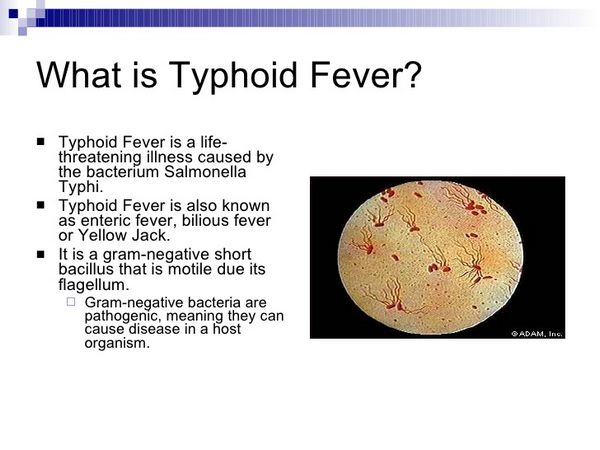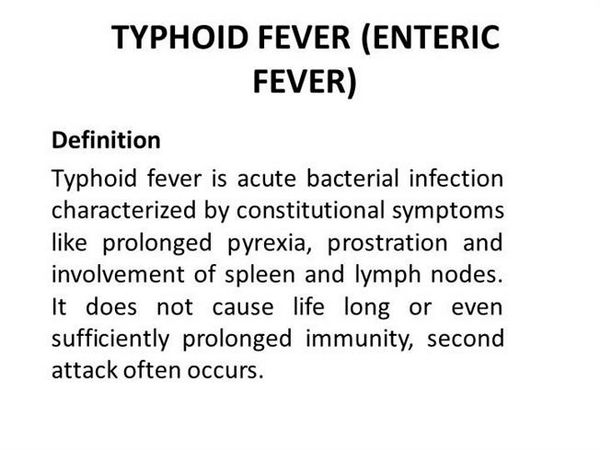Clinical Findings
Signs and Symptoms
Patients are asymptomatic during the incubation phase. Early in the course of disease, patients may experience diarrhea or constipation. Patients then develop a variety of nonspecific symptoms, such as fever, chills, weakness, malaise, myalgia, and cough. Signs, that are not always present, such as rose spots, paroxysmal bradycardia in sharp contrast to the clinical presentation and elevated temperature, and hepatosplenomegaly are clues to the diagnosis. Profound mental status changes and picking at bed clothing, termed typhoid psychosis, may develop in some patients with enteric fever. The middle phase of disease is the time of maximal symptomatology. If complications do not intervene (see below), patients begin to feel progressively better through the latter half of the disease course.

Laboratory Findings
Blood culture is superior to stool culture during the early to mid stages of disease. During the first half of the disease course, bone marrow cultures have the greatest yield but are more difficult to obtain. Peripheral blood findings are variable, and pancytopenia may be seen. During the latter half of the disease course, stool cultures and occasionally urine cultures become positive and provide greater yields than blood cultures.
Differential Diagnosis
Typhoid fever was so named because of its clinical resemblance to typhus, the louse-borne rickettsial disease. The causative organisms are not closely related and are transmitted by very different mechanisms, but both may cause nonspecific signs, such as fever and rash. In addition, both of these diseases occur in impoverished areas and cause epidemics during war. Because of a better understanding of the microbiology, pathophysiology, and histopathology of these diseases, distinguishing between these diseases today is no longer a problem. An accurate diagnosis is usually made through the combined use of serology, culture, and immunohistochemistry. Other infectious diseases, such as visceral leishmaniasis and malaria, may produce fever and hepatosplenomegaly similar to that seen in typhoid fever. These as well as other infectious and noninfectious causes of hepatosplenomegaly are excluded by history, physical examination, laboratory studies, and, in some instances, liver biopsy.

Complications
A characteristic of the enteric fevers is extensive Peyer’s patch and mesenteric lymphoid hyperplasia. The mucosa overlying the Peyer’s patches becomes thinned and often necrotic, which creates a breach in the mucosal barrier and a conduit through which coliform bacteria may invade the bowel wall. Extensive shedding of the necrotic mucosa and underlying lymphoid tissue results in ulceration. Perforation and peritonitis may occur. Massive intraluminal or intra-abdominal hemorrhage may result if ulceration or perforation involves mesenteric blood vessels. These severe complications manifest in ~ 10%-15% of untreated patients with typhoid fever.
Intestinal perforation usually occurs during the latter portion of the middle stage or the early portion of the late stage, when symptoms are beginning to wane. Perforation may present as worsening abdominal pain or rapidly progressive hypotension if hemorrhage occurs. In the absence of rapidly progressing hypotension, abdominal imaging is useful in advanced typhoid fever if perforation is suspected. Emergency surgery is necessary for survival.
The development of a chronic carrier state is a complication of enteric fever and is of more importance to the public health system than to the patient. Chronic carriers shed viable, pathogenic organisms into the environment and serve as sources for subsequent outbreaks. S typhi is the serotype that is most often associated with the chronic carrier state. Much more rarely, patients infected with other serotypes may develop a chronic carrier state. Most often, chronic carriers harbor S typhi in the gallbladder in association with calculi. Urinary tract carriage is associated with Schistosoma haematobium infection or urinary tract calculi. Chronic carriers require long-term therapy, follow-up cultures, and occasionally surgery for the eradication of these organisms.
Diagnosis
In the appropriate clinical setting, the definitive diagnosis of enteric fever requires isolation and biochemical characterization of the etiologic agent. Febrile patients who have visited endemic areas may have enteric fever. Some patients with enteric fever may have an insidious onset, but eventually become severely ill. The Widal antigen/antibody agglutination is a presumptive test that is still used for the diagnosis of typhoid fever. This test, however, lacks both sensitivity and specificity. Blood and/or bone marrow culture, followed by empiric therapy, is a more reliable method of diagnosing enteric fever. Early in the course of disease, blood and bone marrow cultures yield the highest recovery of organisms, while later in the course of disease, stool and sometimes urine cultures are more likely to become positive. The submission of appropriate specimens for culture is important, so that rapid isolation of the causative agent and susceptibility testing can be performed. Antimicrobial susceptibility testing is necessary to optimally direct therapy, because of possible antimicrobial resistance.
Treatment
Chloramphenicol, TMP/SMX, ampicillin, third-generation cephalosporins, and quinolones have been used successfully for the treatment of enteric fever (Box 5). Unfortunately, antimicrobial resistance has emerged to each of these agents. Some Salmonella isolates are multidrug resistant. For this reason, whenever possible, antimicrobial therapy should be based on an individual isolate’s susceptibility profile, obtained by standard methods. Until such data are available, empiric therapy should be used, based on known antimicrobial-resistance profiles.
Chloramphenicol was the first drug used for the treatment of typhoid fever. However, increasing resistance, high relapse rates, bone marrow toxicity, and the promotion of a chronic carrier state have limited its usefulness. If isolates are susceptible to chloramphenicol, advantages include its high efficacy, low cost, and oral administration.
Ampicillin and TMP/SMX were used to treat enteric fever after chloramphenicol resistance emerged. For susceptible isolates, these drugs are effective, easily administered, and do not have the high rate of relapse associated with chloramphenicol.
The third-generation cephalosporin, ceftriaxone, is highly effective for the treatment of typhoid fever in adults and children. Third-generation cephalosporins are especially useful as empiric therapy in areas in which multiple-drug resistance has been reported. When the susceptibility profile of a particular isolate is known, the antimicrobial agent may be changed to a drug with a narrower spectrum of activity. Hopefully, this will also diminish the selection of organisms with resistance to third-generation cephalosporins.
Currently, ciprofloxacin is the drug of choice for adults from India, Asia, or the Middle East. In these areas, S typhi strains that are resistant to chloramphenicol, ampicillin, and/or TMP/SMX have been reported. Chromosomally mediated quinolone resistance has emerged, however, but it is hoped that it will not spread as rapidly as the plasmid-mediated resistance to chloramphenicol, ampicillin, and TMP/SMX. First- and second-generation cephalosporins and aminoglycosides should not be used to treat S typhi infections, regardless of the in vitro susceptibility profile. Patients with typhoid fever who develop mental status changes may benefit from a short course of dexamethasone.




